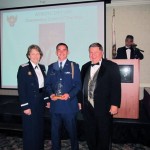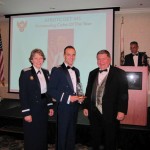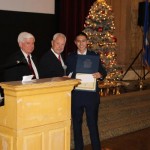Norma Burns recalls in detail the day she had her first appointment with San José State University Justice Studies students from the Records Clearance Project in 2011 for a speed screening.
“I went in there and there was another lady there as well,” Burns said, adding that when the student volunteer walked away to consult an attorney, the young woman started crying. “I went over and I was consoling the woman. She was like, ‘My rap sheet is so long, I’m not going to be able to get my record expunged.’ I told her she had already made the first step because she had come here.”
Since 2008, Record Clearance Project students and volunteers have provided 32,000 hours of service. According to the team’s estimates the market value of RCP services is 10 times the actual cost to run the program.
-
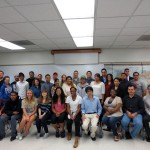
-
Students enrolled in the Fall 2014 Records Clearance Project course pose for a photo. The students help Santa Clara County residents expunge their records.
-
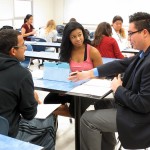
-
Students in the Records Clearance Project work together to write summaries of why individual’s records should be expunged and present those summaries in court.
-

-
Students involved in the Records Clearance Project take two-courses to complete the program, with lots of partner work involved.
Heritage Society Luncheon Presentation
In October, Project Director Peggy Stevenson, Lisseth Castillo-Valencia, a project coordinator and Burns presented an update on the project at the SJSU University Advancement’s annual Heritage Society Luncheon at Flames Eatery and Banquet, with donors who have made a planned gift to the university in attendance.
During the presentation, the team informed attendees that one in four adults in California has an arrest or conviction record, which can interfere in their ability to get employment, housing, student loans, public benefits and in other intangible ways such as causing low self-esteem.
The Records Clearance Project coordinators work to inform people that California law allows the court to dismiss, or expunge, many criminal convictions and helps some residents work through the process.
“Speaking from personal experience, I have helped clear the records for six people and I have had sleepless nights,” Castillo-Valencia said, who took the classes as a student. “I have worked 40 to 50 hours a week on putting together the petitions, but it wasn’t hard to dedicate that much time because we know how important this was to my clients that the amount of hours I put in didn’t matter as long as I did the best job to prepare the petitions for court so the judge could see what we have seen in our clients.”
Tina Daniels, the director of Planned Giving for University Advancement, said she received “wonderful, complimentary and positive comments about the Records Clearance Project, as most of those in attendance were unaware of it.”
Last year, students assisted 214 people with writing petitions to have their records cleared of convictions or to have eligible felonies reduced to misdemeanors. The students attended the most recent RCP hearing on Nov. 18, when a judged listened to RCP petitions in a special court session.
Not including the most recent session, judges have heard 699 cases filed on behalf of 226 people since the start of the program, with 99 percent of the convictions expunged and 94 percent of eligible felonies reduced to misdemeanors.
A personal history
In 2011, Burns was one of those people to have her record successfully expunged, when she started working as a volunteer to help others through the process. She was hired in Feb. 2014 to work as a mentor with the clients of the program and she is open about her checkered past.
Burns’ first experience at SJSU was as a homeless teenager, when she would sleep in booths at the Student Union that were available for reservation by students.
“They used to have a radio station there and there was a deejay at the time who would let me know which booths were available and I used to go there to sleep,” she said.
Burns, now 55, said she was a functioning crack addict for years who managed to stay employed. She and her 10-year-old daughter would stay in her car or sometimes in the attic of someone they knew. Her son had chosen to live with his father rather than with her.
“I was just bouncing from place to place and didn’t have a sense of direction,” she said.
She was arrested three times on different charges, including fraud and assault. She was court ordered to undergo an anger management program. When she did not complete it, she was arrested on a bench warrant.
She was sentenced to a year in jail and completed eight months of her sentence. When she got out in 2004, she said she was prepared to change her life.
“I just fell on my knees and prayed to God to make me a better person,” she said. “I can’t do this anymore.”
Since then, Burns said she has stayed off drugs and out of trouble with the law. She was able to get a job and a place to live. When she heard about the Records Clearance Project, she decided to try to get her record expunged.
“So many doors have opened for me,” she said, since clearing her record. “It’s like I have a better job and a better place to live. My confidence is like out of this atmosphere. I believe so much in others and believe in change.”
Burns said the cost alone would have kept her from completing the expungement process on her own, as the average is $1,000 for filing paperwork with an attorney’s assistance.
“My metaphor for Peggy is like when you throw a pebble in water and it makes rings that get bigger and bigger,” Burns said. “She’s like a rolling stone rolling down a hill of snow that gathers more momentum. It is such a learning experience and teaches so much.”
Student impact
Yevgeniy Mayba, currently a master’s student in Justice Studies, initially signed up for the two-course Records Clearance Project, JS 140 and JS 141 as an undergraduate because “it appeared to be an easy way to obtain credits for two classes while also getting the internship requirement out of the way,” he said via email.
“During the first two meetings of the JS 140 class, however, I came to see that this would be more than just a couple of classes,” he said. “Peggy repeatedly stressed the commitment that would be required to participate in the project and the seriousness of dealing with people’s lives and hopes.”
Mayba said the hardest part of the class was working with a partner.
“As we all have different writing styles and opinions on what is important and should be included in the petition, writing petitions as a team was challenged,” he said. “We had to adapt to one another and learn to compromise, as well as to not be afraid to criticize each other and to be able to receive constructive criticism with grace.”
Mayba said he wants to pursue a career with prisoner reentry or inner city youth in the future.
“The most rewarding part of working with the Records Clearance Project was the realization that I was making a difference in people’s lives,” Mayba said. “Being able to help people get a fresh start in their lives and seeing tears of joy in their eyes was the greatest reward anyone could ask for.”
Another student, Rochelle Rotea, created a Facebook page to help promote the work of the RCP and has also created a crowd-funding campaign through Crowdrise. Visit the facebook page at: https://www.facebook.com/recordclearanceproject. Visit the Crowdrise campaign page at: https://www.crowdrise.com/recordclearanceproject/fundraiser/towerfoundationofsan
Donors, partners keep project going
Since its inception in 2008, the Records Clearance Project has been supported by community partnerships, support from the County of Santa Clara and donations of money or in-kind support from foundations, individual donors and law firms.
Some of the contributors include:
The County of Santa Clara
Foundations
The Castellano Family Foundation
Google Donations for Doers (for volunteer hours of Shaun Warren)
Jewish Community Federation
Philanthropic Ventures Foundation
The Skoll Fund
The Health Trust
Law Firms
Goldstein, Demchak, Baller, Borgen & Dardarian Foundation
Kazan, McClain, Satterly & Greenwood Foundation
Morrison & Foerster Foundation
Rosen Bien Galvan & Grunfeld LLP
Rossi, Hamerslough, Reischl & Chuck
Wilson Sonsini Goodrich & Rosati Foundation
Individuals
Anonymous
Yvette Boddie
Yvonne and Alvin Gimbal
Amanda Hawes
Christopher Ho
Cheri Houle
David and Bette Loomis
Brian James
Jocelyn Larkin
Yulanda Lincoln
Maria Marroquin
William McAlister
Faye McNair-Knox
Paul McNamara
Lorrence and Beverly Otter
Kate Pohl
Anna Ranieri
Irene Resler
Jorge and Rochelle Rotea
Doris Rose Inda
David and Muriel Rosenthal
Susan Rothschild
Alice Smith
Richard Thesing
Martha and Jerry Uelmen
John Wagers
Judith William
Stewart Wobber
Janet and Mark Zimmerman
Community Partners
Ascent Employment Program Inc.
Bay Area Maranatha Christian Center
Catholic Charities of Santa Clara County
CommUniverCity
Family and Children Services
Goodwill
Salvation Army
South Hills Community Church
SJSU Partners
Andy Trembley, David Kessler, and the SJSU Tech Team
The SJSU School of Social Work and Prof. Gil Villagran
Tony Korshund, Michelle Randle, and all of the CASA Success Center Staff
